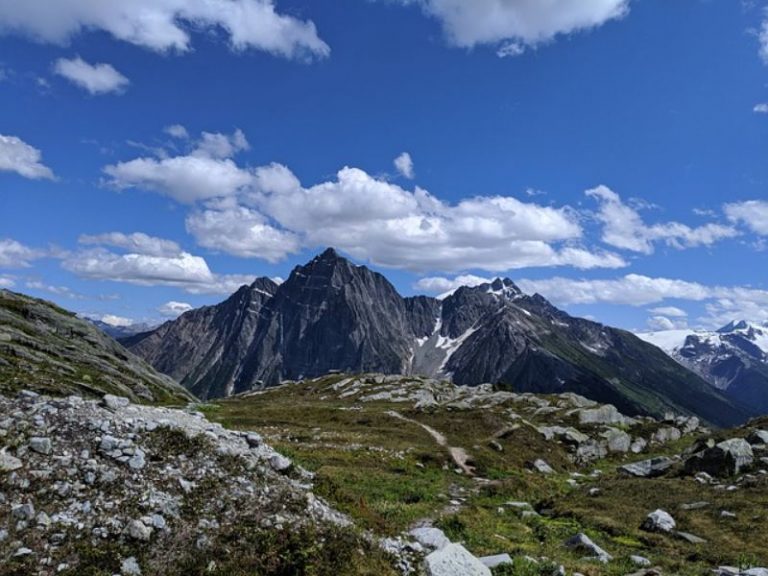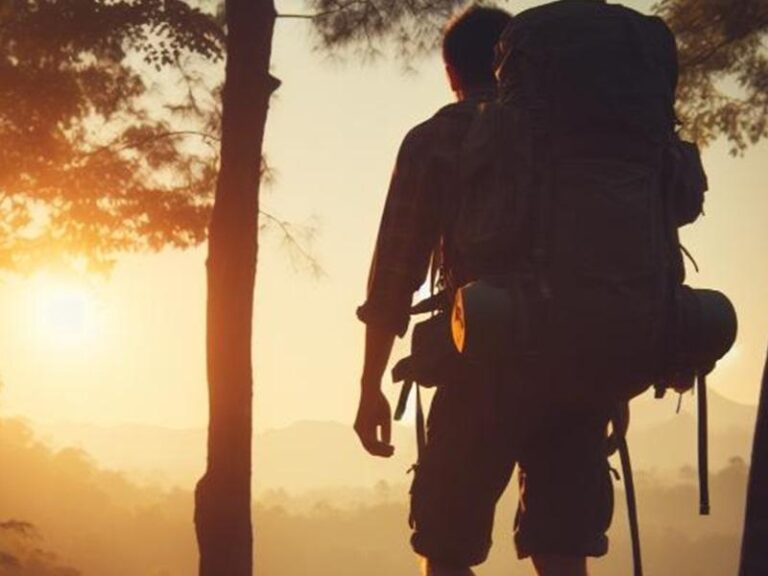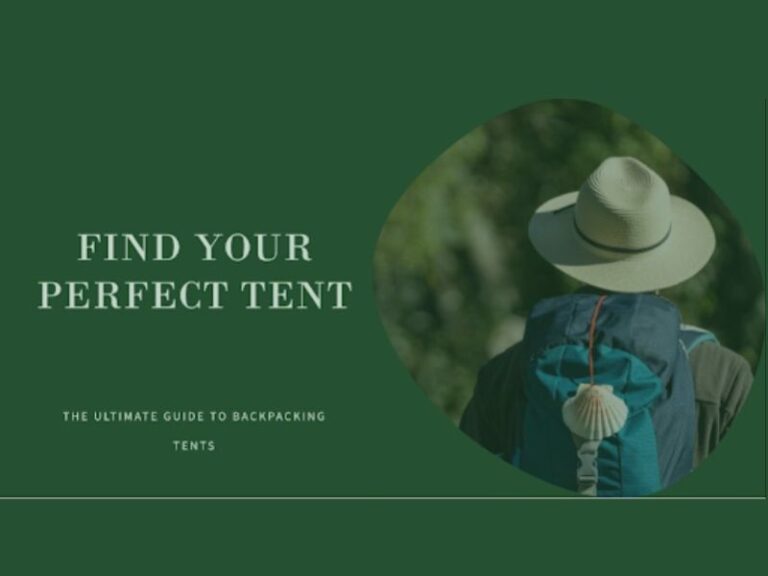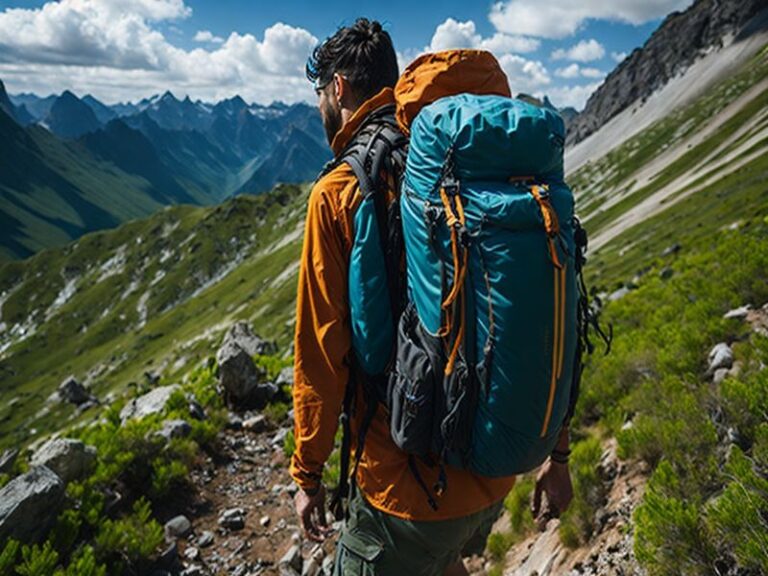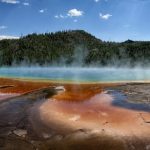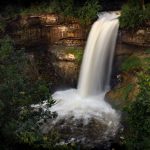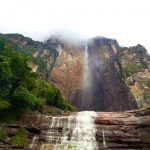Glacier National Park has over 700 miles of trails, and the scenery is absolutely breathtaking. Whether you want to hike to a glacier-fed lake or up a mountain, there is a trail for you.
Best Hiking Trails In Glacier National Park You Need To Explore
15 Best Scenic Hikes in Glacier National Park
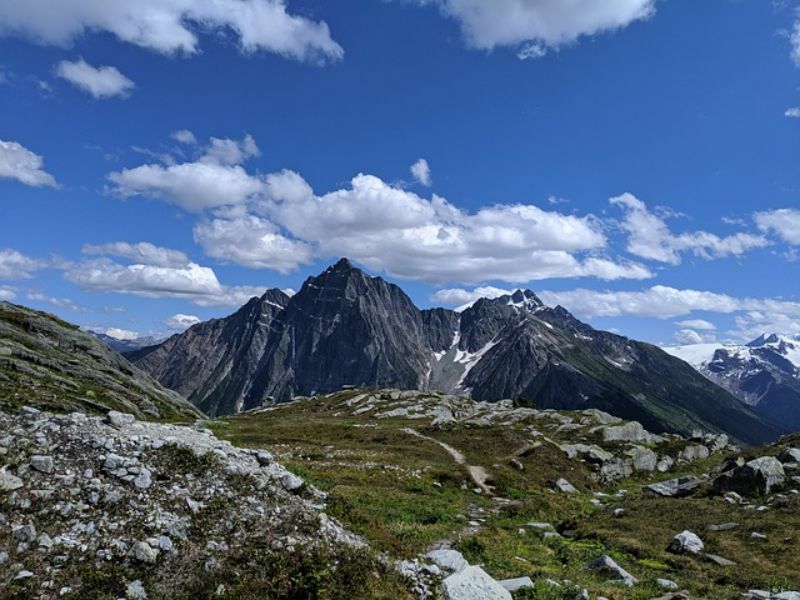
Here are 15 of the best hiking trails in Glacier National Park:
1. Avalanche Lake
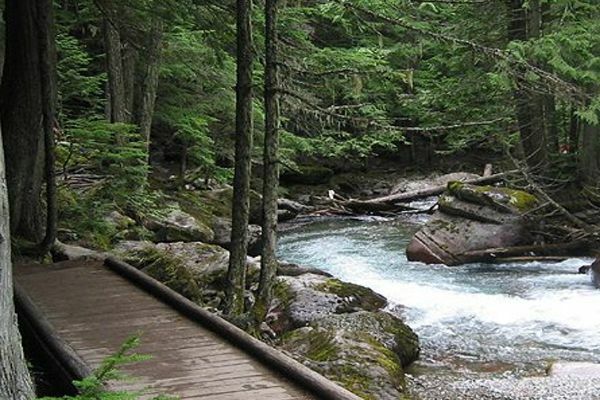
- Difficulty: Moderate
- Distance: 2.3 Miles
- Elevation Gain: 500 Feet
- Length of Time: 1 to 2 hours
- Trailhead: Avalanche Picnic Area
- Location: Lake McDonald
Avalanche Lake Trail
Looking for a moderate hike with a stunning payoff? Look no further than Avalanche Lake! This 2.3-mile hike in Lake McDonald has an elevation gain of just 500 feet, making it a great choice for those looking for a relatively easy hike. The trailhead is located at the Avalanche Picnic Area, and the hike should take between 1 and 2 hours.
The trail itself is quite scenic, winding through forests and past waterfalls before reaching the lake. The lake itself is a beautiful sight, nestled in a valley beneath towering mountains. It’s no wonder this hike is so popular!
So what are you waiting for? Grab your hiking boots and head to Avalanche Lake for a hike you won’t soon forget.
2. Swiftcurrent Pass Trail
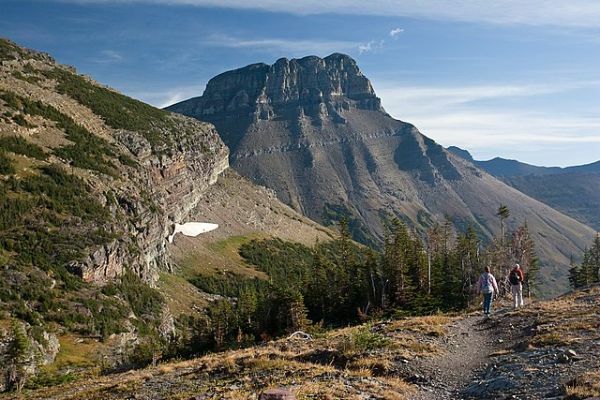
- Difficulty: Hard
- Distance: 6.8 miles
- Elevation Gain: 2,300 Feet
- Length of Time: 5 to 6 hours
- Trailhead: Swiftcurrent Trailhead, by motor inn parking lot
- Location: Many Glacier
Swiftcurrent Pass Trail
Looking for a breathtaking and challenging hike in Many Glacier? Then look no further than the Swiftcurrent Pass Trail!
This 6.8-mile hike will take you through some of the most stunning scenery in the area, including alpine meadows, forests, and of course, sweeping views of the mountains. The elevation gain of 2,300 feet can be challenging, but it is well worth it for the incredible views from the top. Allow 5 to 6 hours to complete the hike, and be sure to start from the Swiftcurrent Trailhead, located by the motor inn parking lot.
3. Hidden Lake Overlook
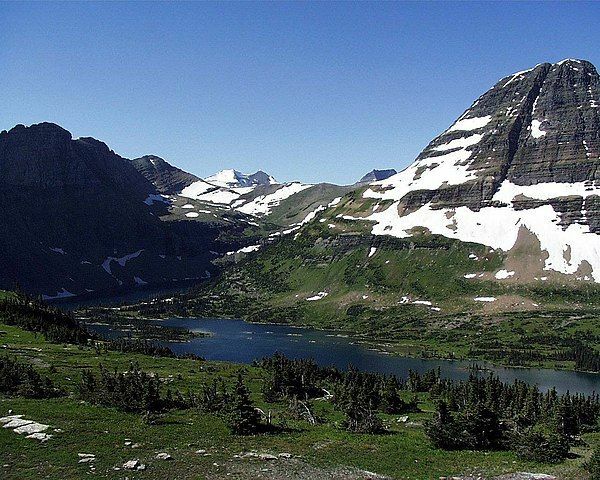
- Difficulty: Moderate
- Distance: 2.8 miles
- Elevation Gain: 460 Feet
- Length of Time: 1 to 2 hours
- Trailhead: Logan Pass Visitor Center
- Location: St. Mary
Hidden Lake Overlook
The Hidden Lake Trail is a moderate 2.8-mile hike in Glacier National Park with an elevation gain of 460 feet. The trailhead is located at the Logan Pass Visitor Center, and the hike takes 1 to 2 hours to complete. The trail offers stunning views of the park’s mountains, lakes, and forests, and is a great way to get some exercise and fresh air.
Glacier National Park is home to some of the most beautiful scenery in the United States. The Hidden Lake trail is one of the best hikes in the park, offering stunning views of Clements Mountain. Depending on the time of year, part of the trail may be closed due to bear activity in the area. Parking is available at the Logan Pass Visitor Center, but it fills up quickly, so get there early.
4. Highline Trail
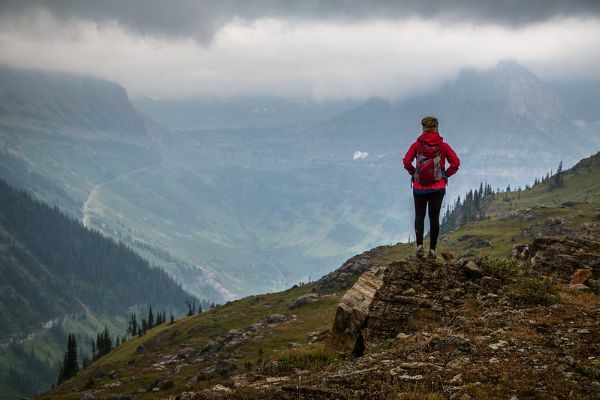
- Difficulty: Hard
- Distance: 14.9 miles
- Elevation Gain: 2,578 Feet
- Length of Time: 6 h 59 to 8 hours
- Trailhead: Logan Pass Visitor Center
- Location: St. Mary
Highline Trail
The Highline Trail is one of the most scenic hikes in the world. It runs along the Continental Divide in the Rocky Mountains of Montana and Wyoming and offers hikers stunning views of some of the most beautiful scenery in the world. The trail is also home to a variety of wildlife, including bighorn sheep, grizzly bears, and elk.
The Highline Trail is one of the most popular trails in the park, and for good reason. This 14.9-mile trail takes hikers through some of the most beautiful scenery in the park, including alpine meadows, forests, and of course, glaciers. The trail is rated as hard, with an elevation gain of 2,578 feet, and it typically takes 6 to 8 hours to complete. The trailhead is located at the Logan Pass Visitor Center, and the trail can be accessed from the St. Mary entrance to the park.
5. Grinnell Glacier Viewpoint
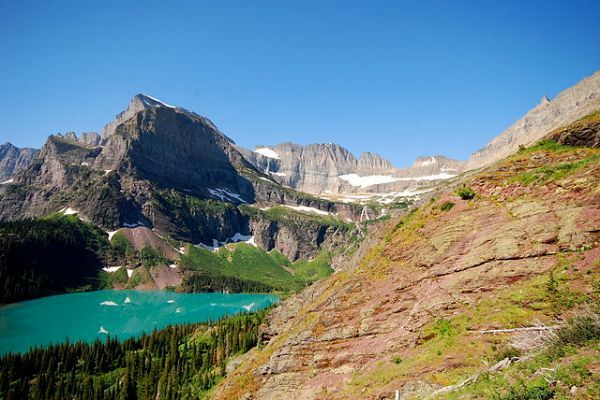
- Difficulty: Hard
- Distance: 5.3 miles
- Elevation Gain: 1,600 Feet
- Length of Time: 2 to 4 hours
- Trailhead: Grinnell Glacier Trailhead or Many Glacier Hotel
- Location: Many Glacier
Grinnell Glacier Viewpoint
The park is home to many scenic hikes, including the Grinnell Glacier Viewpoint hike.
This hike is considered to be one of the more difficult hikes in the park, with an elevation gain of 1,600 feet. The hike should take between 2 and 4 hours to complete.
The trailhead for the hike can be found at the Grinnell Glacier Trailhead or at the Many Glacier Hotel. The hike is located in the Many Glacier area of the park.
This hike offers stunning views of the Grinnell Glacier. The glacier is one of the most popular attractions in the park.
If you are looking for a challenging hike with beautiful views, the Grinnell Glacier Viewpoint hike is the perfect hike for you.
6. Cracker Lake
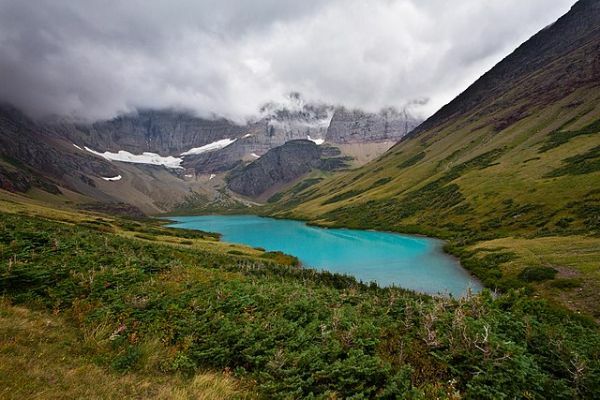
- Difficulty: Moderate
- Distance: 12.8 miles
- Elevation Gain: 1,400 Feet
- Length of Time: 6 to 8 Hours
- Trailhead: South end of Many Glacier Hotel parking lot
- Location: Many Glacier
Cracker Lake Trail
Cracker Lake is a beautiful, serene lake located in Glacier National Park. The lake is 12.8 miles long and 1,400 feet deep, making it a popular destination for hikers and nature lovers alike. The trailhead is located at the south end of the Many Glacier Hotel parking lot, and the hike takes approximately 6 to 8 hours to complete.
Remember to bring your bug spray, as the insects can be quite bothersome on this trail. Bear sightings are also common, so make sure to have your bear spray handy and make noise as you hike.
7. Iceberg Lake
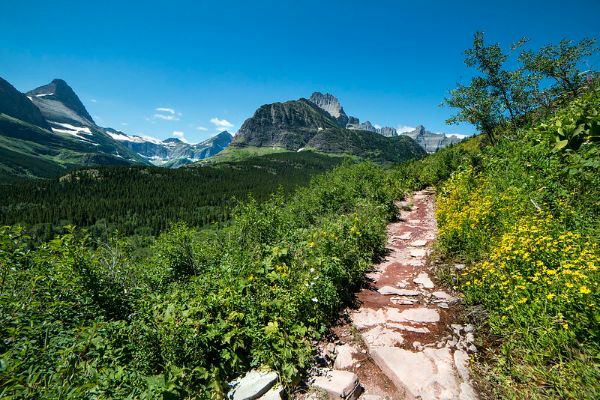
- Difficulty: Moderate
- Distance: 4.8 miles
- Elevation Gain: 1,200 Feet
- Length of Time: 2 to 3 hours
- Trailhead: Trailhead: Iceberg Ptarmigan Trailhead
- Location: Many Glacier
Iceberg Lake Trail
Glacier National Park is home to some of the most beautiful scenery in the United States. From towering mountains to pristine lakes, the park has something for everyone. One of the best ways to experience the park is by hiking one of the many scenic trails.
One of the most popular trails is the Iceberg Lake Trail. The trail is moderate in difficulty and is 4.8 miles long. The elevation gain is 1,200 feet, and the hike takes 2 to 3 hours. The trailhead is located at the Iceberg Ptarmigan Trailhead in Many Glacier.
The Iceberg Lake Trail is a great way to experience the beauty of Glacier National Park. The trail offers stunning views of the lakes and mountains and is a great workout. The trail is also relatively short, making it a great option for those who don’t have a lot of time.
8. Apgar Lookout Trail
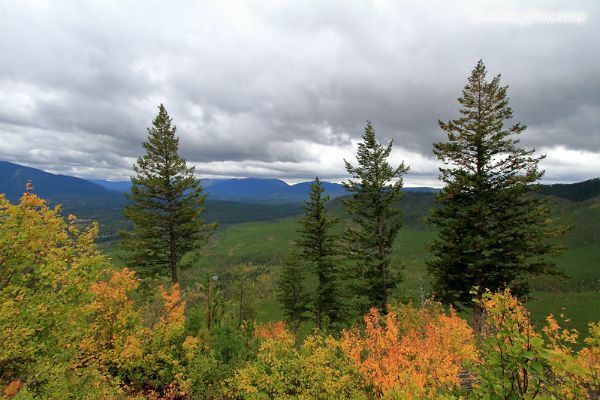
Difficulty: Hard
Distance: 3.6 miles
Elevation Gain: 1,850 Feet
Length of Time: 2 to 3 hours
Trailhead: Turn left 0.5 miles north of the West Entrance, continue 1.5 miles beyond Quarter Circle Bridge
Location: Lake McDonald
Apgar Lookout Trail
The Apgar Lookout Trail is a difficult 3.6-mile hike with an elevation gain of 1,850 feet. The trailhead is located 0.5 miles north of the West Entrance to Lake McDonald, and the hike should take 2 to 3 hours to complete.
The trail begins at the Quarter Circle Bridge and winds its way through the forest to the Apgar Lookout. The views from the lookout are stunning, and on a clear day, you can see for miles. The trail is well-marked and easy to follow, but it is steep in places and can be slippery when wet.
If you are planning on hiking the Apgar Lookout Trail, be sure to wear sturdy shoes, bring plenty of water, and be prepared for a challenging hike.
9. Redrock Falls
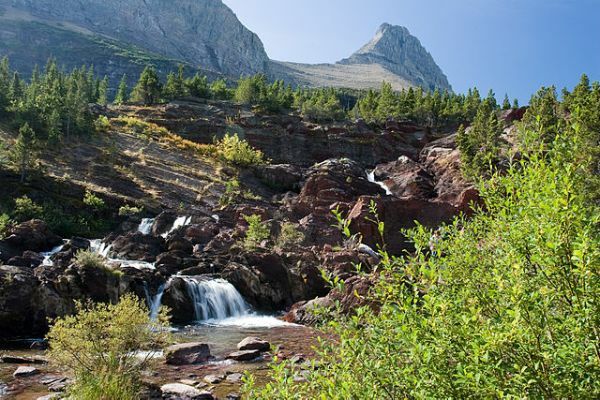
- Difficulty: Easy
- Distance: 1.8 miles
- Elevation Gain: 100 Feet
- Length of Time: 2 to 3 hours
- Trailhead: Swiftcurrent Trailhead, by motor inn parking lot
- Location: Many Glacier
Redrock Falls Trail
The Redrock Falls Trail is a beautiful and relatively easy hike that is perfect for those who want to enjoy the stunning scenery of Many Glacier without having to commit to a long or difficult hike.
The trail is only 1.8 miles long and has a relatively gentle elevation gain of only 100 feet, making it a great option for those who are looking for a relatively easy hike.
The trailhead is located at the Swiftcurrent Trailhead, which is easily accessible from the motor inn parking lot. The hike should take between 2 and 3 hours to complete.
10. Ptarmigan Tunnel Trail
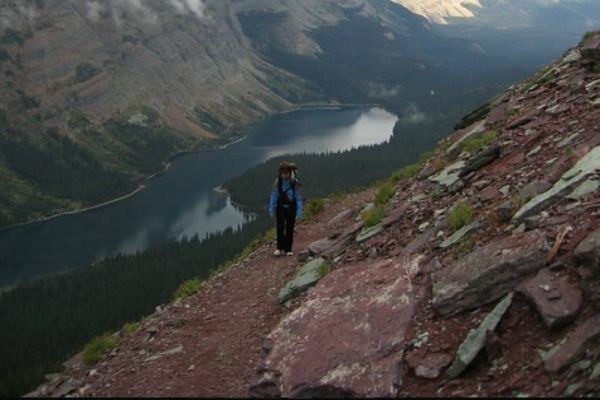
- Difficulty: Hard
- Distance: 5.3 miles
- Elevation Gain: 2,300 Feet
- Length of Time: 5.5 to 7 hours
- Trailhead: Iceberg Ptarmigan Trailhead
- Location: Many Glacier
Ptarmigan Tunnel Trail
Ptarmigan Tunnel is one of the most popular trails in Glacier National Park. The trail is known for its dramatic scenery, including alpine meadows, waterfalls, and its namesake tunnel. The tunnel was built in 1930 and is one of the only ways to access the Ptarmigan Wall, a popular climbing spot.
The trail is considered to be difficult, with a distance of 5.3 miles and an elevation gain of 2,300 feet. It is recommended that hikers allow 5.5 to 7 hours to complete the hike. The trailhead is located at the Iceberg Ptarmigan Trailhead in Many Glacier.
Those looking for a challenge will find it on the Ptarmigan Tunnel Trail. With stunning views and a unique tunnel, the trail is a must-do for any Glacier National Park visitor.
11. St. Mary and Virginia Falls Trail
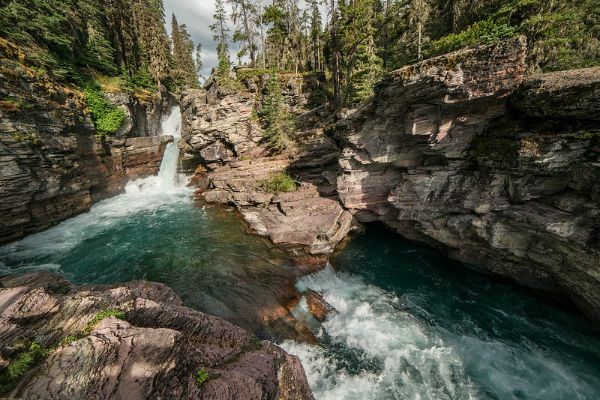
- Difficulty: Moderate
- Distance: 3.6 miles
- Elevation change: loss 260 ft (79 m), then gain 285 ft (87 m)
- Length of Time: 1.5 to 2 hours
- Trailhead: St. Mary Falls Shuttle Stop
- Location: St. Mary
Virginia Falls Trail
St. Mary and Virginia Falls Trail is a moderate 3.6-mile hike with an elevation change of 260 ft (79 m) followed by a 285 ft (87 m) gain. The hike should take 1.5 to 2 hours and starts at the St. Mary Falls Shuttle Stop.
The falls are beautiful and the scenery is different than anything else in the park. The first part of the trail is easy, but it gets more difficult as you approach the second falls. The trail is rocky and there are areas where you have to scramble up rocks.
The views from the top of the falls are worth the effort, but be careful as the rocks can be slippery.
12. Kintla Lake Head
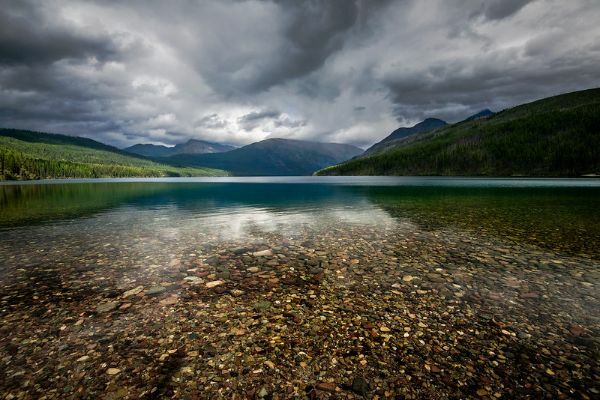
- Difficulty: Moderate
- Distance: 6.6 miles
- Elevation Gain: 892 Feet
- Length of Time: 4 to 5 hours
- Trailhead: 0.25 miles west of Kintla Lake Campground
- Location: North Fork & Goat Haunt
Kintla Lake Head
If you’re looking for a moderately difficult hike with stunning views, look no further than the Kintla-Keystone Divide. This 6.6-mile trail in North Fork & Goat Haunt will take you through the forest and alpine meadows, and you’ll be rewarded with views of Kintla and Karelia Lakes.
The trailhead is located 0.25 miles west of Kintla Lake Campground, and the hike should take 4 to 5 hours. Be sure to pack plenty of water and snacks, as there is no water available along the way. The elevation gain is 892 feet.
This is a popular hike, so you may want to start early to avoid crowds. But even if you don’t, the views are worth it. So lace up your hiking boots and enjoy the Kintla-Keystone Divide.
13. Baring Falls Hike
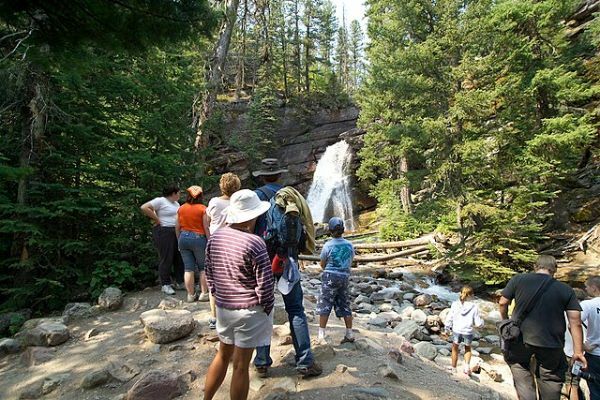
- Difficulty: Easy
- Distance: 0.3 miles
- Elevation Gain: 108 feet
- Length of Time: .5 to 1 hour
- Trailhead: Sunrift Gorge PulloutGoing-To-The-Sun Road.
- Location: Many Glacier
Baring Falls Trail
A short and easy hike to Baring Falls is a great way to experience the incredible scenery of Glacier National Park.
The falls are located on the Sunrift Gorge, a glacial carved canyon on the Going-To-The-Sun Road. The trailhead is located at the Sunrift Gorge Pullout and is only 0.3 miles from the road. The hike is gentle, with an elevation gain of only 108 feet, and can be completed in just .5 to 1 hour.
The falls themselves are beautiful, and the views of the canyon from the trail are stunning. This is a great hike for those looking for an easy way to experience Glacier National Park.
14. Cobalt Lake
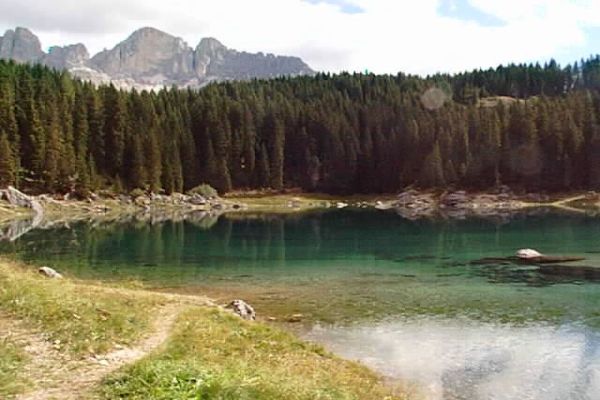
- Difficulty: Easy
- Distance:5.8 miles
- Elevation Gain: 1,400 feet
- Length of Time: 5 to 6 hours
- Trailhead: South Shore Trailhead
- Location: Two Medicine
Cobalt Lake Trail
The Cobalt Lake Trail is the perfect hike for those looking for an easy, yet stunningly beautiful hike. This 5.8-mile trail is located in the Two Medicine area and offers hikers breathtaking views of Cobalt Lake as well as the surrounding mountains. The elevation gain is only 1,400 feet, making it a relatively easy hike, and it can be completed in 5 to 6 hours. The South Shore Trailhead is the starting point for this hike and can be easily accessed from the town of Two Medicine.
The Glacier National Park is a beautiful and unique place that is enjoyed by many visitors each year. The park is home to many different types of plants and animals, and it is important to take steps to protect these resources. One way to do this is to follow the Leave No Trace Principles.
What You Need to Know About Glacier National Park
Glacier National Park is one of the most popular tourist destinations in the United States, attracting over 3 million visitors each year. The park is home to a variety of wildlife, including grizzly mountain goats, black bears, bighorn sheep, wolverines, moose, grey wolves, and mountain lions. Visitors can also enjoy the park’s stunning mountain views, numerous waterfalls, and 26 glaciers.
There are hundreds of miles of hiking trails in Glacier National Park, ranging from easy walks to strenuous multi-day backpacking trips. In this article, we’ll explore some of the best hikes in the park, divided into five main regions. We’ll also give you some tips on when to visit, how to get around, and what gear to bring.
So whether you’re a seasoned hiker or a first-time visitor, read on to find the perfect hike for you in Glacier National Park.
Glacier National Park 5 Main Regions Regions
1. Lake McDonald Valley Region
The Lake McDonald Valley Region is located on the western side of Glacier National Park, along the stunning Lake McDonald. This region is one of the most popular in the park, offering stunning scenery, plenty of recreational opportunities, and easy access to many of the park’s most popular attractions.
2. St. Mary and Logan Pass Region
St. Mary and Logan Pass region is a beautiful and popular area located east of Lake McDonald Valley and Logan Pass. Logan Pass is the highest point that can be reached by car on the Going-to-the-Sun Road. This region is home to many popular attractions, including the St. Mary Visitor Center, the Logan Pass Visitor Center, and the Highline Trail.
3. Two Medicine Valley Region
The Two Medicine Valley is a beautiful and lesser-known region of Glacier National Park. With its rushing waterfalls, dramatic views, and reflective lakes, it is sure to impress any visitor.
4. Many Glacier Valley Region
The Many Glacier Valley Region in Glacier National Park is an excellent area to explore and should not be missed. It is located on the eastern side of the park and provides a more remote and less crowded experience than other areas of the park.
5. North Fork and Goat Haunt Region
The North Fork and Goat Haunt regions of Glacier National Park are located on the northwestern side of the park. North Fork is only accessible by unpaved roads, while Goat Haunt requires backcountry hiking access.
Best Time to Visit Glacier National Park
Every year, millions of people visit the park to take in the spectacular scenery and enjoy the many activities that the park has to offer. While summer is the busiest time of year at the park, with warm weather and all of the park facilities open, my favorite time to visit is early to mid-September. The weather can be awesome in the fall and it is a great time to avoid the crowds and find some solitude on the trails.
How to Reserve Entrance Pass
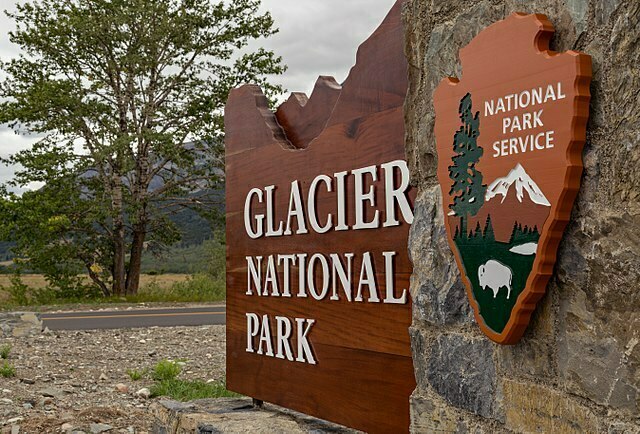
You can purchase a site-specific digital pass for Glacier National Park on Recreation.gov. This pass will give you access to the park and all its amenities. You can easily download the pass on your phone or tablet, or print it out when you arrive.
Entrance Fees:
Glacier National Park charges different rates for entrance, depending on the type of visitor and vehicle. Fees & Passes
Private vehicles are charged a $35 entrance fee to the park, which is valid for 7 days. This fee is reduced to $25 during the winter months (November 1 to April 30). All visitors in a single, private, non-commercial vehicle must purchase this pass, which is non-transferable. If the entrance station is not staffed, there is a self-registration area where visitors can purchase a 7-day park pass.
The entrance fee for individuals is $20.00 for a 7-day pass. The winter rate is $15.00, from November 1 to April 30. This fee is per person for visitors traveling on foot, by bicycle, or in a vehicle as a non-commercial, organized group. The pass is non-transferable.
The winter rate for motorcycle entrance is $20.00. This permit is non-transferable and is only valid from November 1 to April 30.
Glacier National Park Annual Pass is a great way to enjoy all the park has to offer. It costs $70 and allows access to all of the park’s facilities for one year. This pass is a great value and is a great way to save money on park fees. This pass is valid for one year from the month of entry and admits the purchaser and passengers in a single, private, non-commercial vehicle, or the pass holder and his/her immediate family spouse, children, and parents when entry is by other means foot, bicycle into the park. It is nontransferable, nonrefundable, and does not cover camping fees.
How to Get Around in Glacier National Park
One of the best ways to experience Glacier is by taking advantage of the free shuttle service that runs along Going-to-the-Sun Road.
The shuttle service is available on a first-come, first-served basis, and runs from early summer through Labor Day. The shuttles are wheelchair-accessible and have bike racks, making them ideal for exploring all the park has to offer. Pets, smoking, and open alcohol containers are not allowed on the shuttles. Bear spray must be securely fastened to prevent accidental discharge.
Glacier National Park is a beautiful place to visit any time of year, but the fall months offer a unique experience. Take advantage of the free shuttle service and explore all the park has to offer. Going-to-the-Sun Shuttle Service
Essential Hiking Gear for Glacier National Park
This National Park is a hiker’s paradise. With over 700 miles of trails, there is something for everyone. However, before heading out into the backcountry, it is important to be prepared. Here is a list of essential gear for a safe and enjoyable hike in Glacier National Park.
Footwear:
Appropriate footwear is essential for a safe and enjoyable hike. Be sure to wear sturdy, broken-in shoes or boots with good traction. Avoid cotton socks, Wool socks are a great option because they are moisture-wicking and will keep your feet warm in the cold weather.
For men, we recommend the Columbia Newton Ridge Plus Ii, Hiking Boot. These boots are lightweight and provide great support and stability on uneven terrain. They’re also waterproof, so you won’t have to worry about your feet getting wet if you cross a stream or puddle.
For women, we recommend the Columbia Women’s Newton Ridge Plus Hiking Shoe. These boots are also lightweight and provide good support and stability. They’re waterproof and have a higher ankle for added protection.
Water:
Water is essential for any hike. Be sure to bring a water bottle that can be refilled at one of the park’s many water fountains. A stainless steel water bottle is a good choice, as it will keep your water cold even in the hot summer months.
High-Energy Snacks:
High-energy snacks: When you’re hiking, your body burns a lot of calories. It’s important to have some high-energy snacks with you to keep your energy levels up. Some good options include energy bars, trail mix, and dried fruit.
Rain Gear and Extra Clothing:
When you and your partner are planning a hike together, be sure to pack the right gear to keep yourselves dry and comfortable. A good rain jacket is essential to have in your backpack, and we’ve got some great options for both men and women.
For men, we recommend the Columbia Men’s Watertight Ii Jacket. This jacket is made with a waterproof and breathable fabric, and it has a hood to keep your head dry. It’s also lightweight and packable, so it won’t take up too much space in your backpack.
For women, we recommend the Columbia Women’s Arcadia Ii Jacket. This jacket is also made with a waterproof and breathable fabric, and it has a hood to keep you dry. It has a flattering fit, and it’s also lightweight and packable.
First Aid Kit:
A basic first aid kit should include bandages, gauze, tape, antibiotic ointment, pain relievers, and antihistamines.
Read More: First aid kits for the great outdoors
Protect Yourself from the Sun:
Hiking is a great way to get some exercise and enjoy the outdoors, but it’s important to take some basic precautions to protect yourself from the sun. Make sure to apply sunscreen, wear sunglasses, and bring a wide-brimmed hat to keep yourself safe from harmful UV rays.
Insect Repellent:
Mosquitoes and other insects can be a nuisance in Glacier National Park. Be sure to pack insect repellent containing DEET.
Camera and Spare Battery:
Don’t forget to bring a camera to capture all of the beautiful scenery in Glacier National Park. Be sure to pack a spare battery as well.
Binoculars:
Binoculars are a great way to get a closer look at the wildlife in the park.
Trash Bag:
Please pack out all of your trash, including food scraps. A garbage bag is a great way to carry out your trash.
Bear Spray:
Bear spray is required for all hikes in Glacier National Park. Be sure to keep it readily accessible, such as in a hip belt or chest holster.
Backpack:
Your backpack is one of the most important pieces of gear when hiking in Glacier National Park. It should be big enough to fit all of your essential gear, but not so big that it’s cumbersome to carry. Look for a backpack with a comfortable hip belt and adjustable straps to ensure a perfect fit. And be sure to pack plenty of food and water—you’ll need it to fuel your adventures.
Tool multi-purpose:
A tool multi-purpose is a must-have for any hiker. It can be used for everything from opening cans to cutting rope.
There you have it—a few essential items to help you enjoy a safe and comfortable hike in Glacier National Park. With these items in your pack, you’ll be prepared for anything the trail throws your way.
Leave No Trace Principles
The Leave No Trace Principles are a set of guidelines that help people enjoy the outdoors while minimizing their impact on the environment. There are seven Leave No Trace Principles:
- Plan ahead and prepare
- Travel and camp on durable surfaces
- Dispose of waste properly
- Leave what you find
- Minimize campfire impacts
- Respect wildlife
- Be considerate of other visitors
- Reduce the Impact of Social Media
By following these principles, we can all help to protect Glacier National Park and ensure that it remains a beautiful place for future generations to enjoy.
Final Thoughts
As the summer season comes to an end, now is the perfect time to plan a trip to Glacier National Park. This park is home to some of the most scenic hiking trails and views in the United States.
There are many different trails to choose from, depending on your level of experience and fitness.
No matter what trail you choose, you’re sure to have an incredible experience. Glacier National Park is a truly special place and should be on everyone’s bucket list.
-
What Are The Main Things You Need For Camping
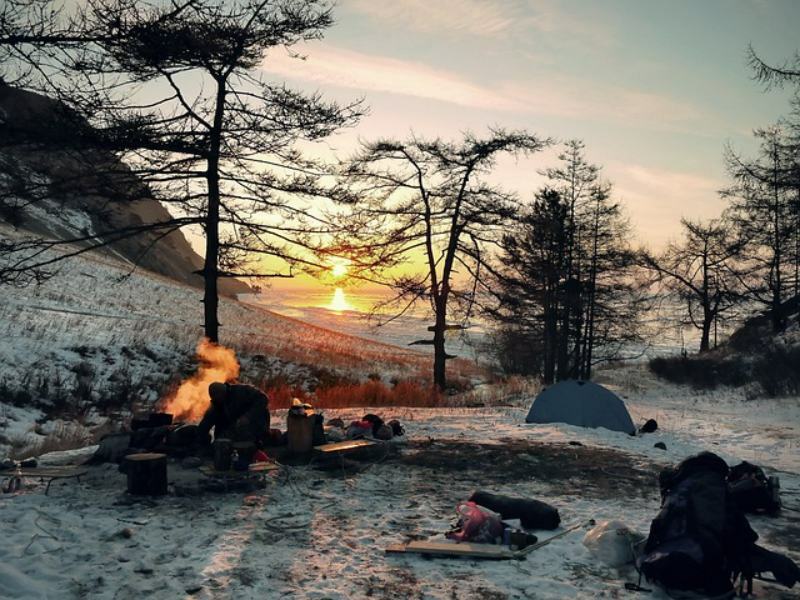
Camping is one of the most enjoyable pastimes available. Who wouldn’t want to go away from the city, pitch a tent beneath the stars, and prepare a delectable supper over an open fire? Camping, whether at campsites, mountains, or on the river, is something I believe everyone should do at least once in their lives.…
-
Best Sleeping Pads for Backpacking and Camping
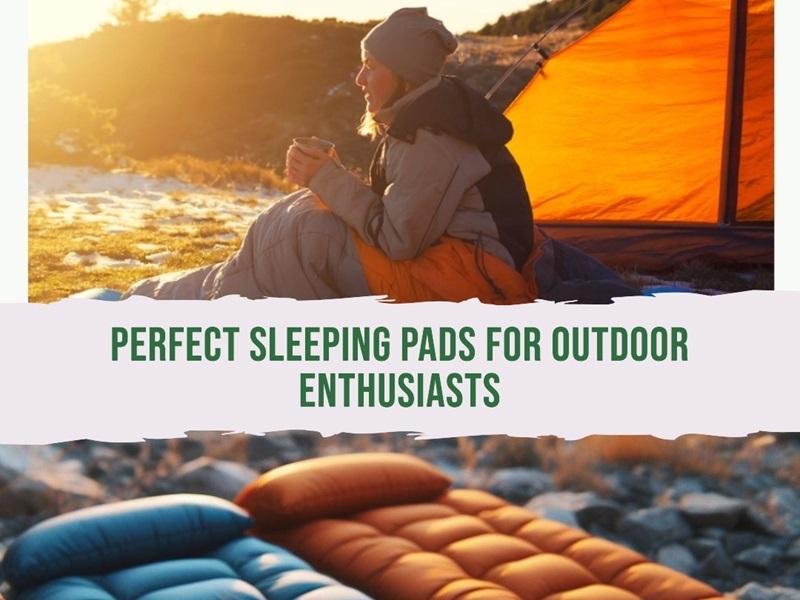
When preparing for a backpacking or camping adventure, choosing the right sleeping pads is essential for rest. The sleeping pad provides insulation from the cold ground and provides cushioning and comfort. This guide covers how to select the best sleeping pads for backpacking and camping based on different activities. Choosing the Right Sleeping Pad Choose…
-
Sleeping Bags Shape

A Comprehensive Guide to Choosing the Right Sleeping Bag Shape for Your Needs: Mummy vs. Oval vs. Rectangular vs. Semi-Rectangular vs. Square When planning your next camping trip, one of the most important decisions you’ll make is choosing the right sleeping bag. With so many different shapes and styles to choose from, it can be…
-
The Best Backpacking Sleeping Bags Under $100 in 2024
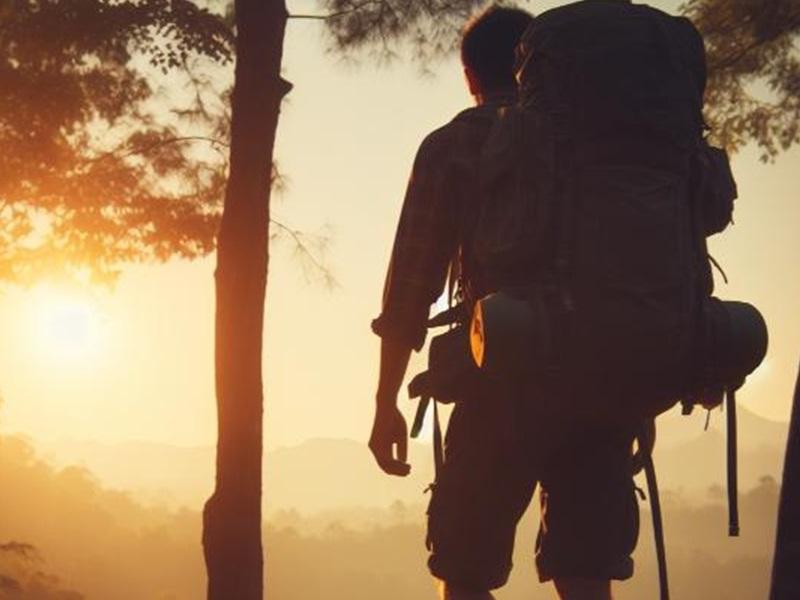
Camping out under the stars is one of life’s great simple pleasures. As the day’s tension fades with the setting sun, you settle into the cozy sanctuary of your sleeping bag, comforted by its warmth. However, not all sleeping bags are created equal when it comes to providing both comfort and portability on the trail. …

